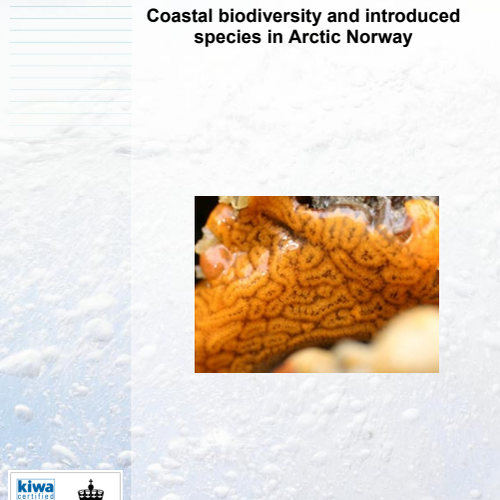6 August 2019 nyhet
Akvaplan-niva has recently published a report from the project "Coastal biodiversity and introduced species in the Arctic, Norway". Through metabarcoding of 32 sediment samples from Kongsfjorden in Arctic Norway, the study concludes that metabarcoding has great potential for monitoring the presence of alien species in environmental samples in the Arctic and could be used to establish a baseline.The study presented in the report has been financed by the Norwegian Environmental Agency. The authors of the report are Ragnhild Pettersen, Paul Renaud (both Akvaplan-niva), Anneke van den Brink (Wageningen University and Research), Martine van den Heuvel-Greve (Wageningen Marine Research) and Arjen de Groot (Wageningen Environmental Research).
BACKGROUND:
Increased concern regarding the introduction of non-native species to Arctic habitats has brought attention to vectors of introduction, taxa expected to invade, and potential consequences of establishment of these introduced species. There is a general lack of coastal sampling and monitoring in Arctic Norway, despite the recognition that many coastal areas are at disproportionately high risk for biodiversity change due to natural (e.g. warming, less shore-fast ice and ice scour) and human factors (introduction of alien species through economic activities).
In Norway, several initiatives have been taken to study this topic. Among these we find the Circumpolar Biodiversity Monitoring Program (CBMP), a component of the Conservation of Arctic Flora and Fauna (CAFF) under the Arctic Council. CBMP-Coast is the final element of a series of biodiversity monitoring programs to be initiated under CAFF. CBMP-Coast is now identifying target areas and focal ecosystem components that would provide a baseline and, hopefully, the foundation of time series across the entire Arctic. In Norway, the habitats under the most focus are rocky shoreline and fjords, and the Økokyst program financed by the Norwegian Environmental Agency has begun monitoring activities in northern Norway and Svalbard.
Recently, two reports have been written based on coastal monitoring needs, partly inspired by CBMP. One highlights the knowledge gaps, prospects, and action plan for monitoring alien species on Svalbard (Thomassen et al. 2017), and the other describes a desired station network and sampling regime for performing Water Framework Directive-relevant activities on Svalbard (Evenset et al. 2017). Both reports suggest ambitious levels of activity, largely focused on the most accessible regions of Svalbard's west coast, and that this should include strong sampling components directed at seafloor communities.
"Marine aliens in Svalbard" a pilot project, financed by the Svalbard Environmental Protection Fund and the Knowledge Base program of Wageningen University and Research (Netherlands). Researchers from Akvaplan-niva and Wageningen University produced barcode sequences of potential invaders to add to an invader database, and conducted metagenomics on shallow water sediments to detect possible arrivals of alien taxa in Svalbard.
In the report, "Coastal biodiversity and introduced species in the Arctic, Norway" the authors have highlighted any potential alien species to Svalbard identified from the "Marine aliens in Svalbard" and compared these results with relevant studies from other Arctic areas.
SUMMARY OF THE REPORT:
Metabarcoding of 32 sediment samples from Kongsfjorden, Norway, identified more than 150 taxa from two areas of the genome (gene CO1 and 18S DNA). From these, one potential alien species, the tunicate Botrylloides violaceus was identified. The potential negative impacts of B. violaceus and other invasive colonial tunicates are significant and increased temperatures in the future are likely to enhance vegetative growth where it has established. The threat suggested by impacts in other invasion areas indicates that targeted action to prevent B. violaceus from entering Svalbard should be initiated. Knowledge of the biodiversity around Svalbard is more sparse than for the more available marine areas. Some species might have been overlooked in the past and received a status as invasive when they are possibly native. These results show that metabarcoding has great potential for monitoring the presence of alien species in environmental samples in the Arctic and could be used to establish a baseline. CBMP- coast expert groups from other arctic areas report on ongoing initiatives to identify arctic aliens to have a proper baseline whereby further biodiversity monitoring effort can be performed.

